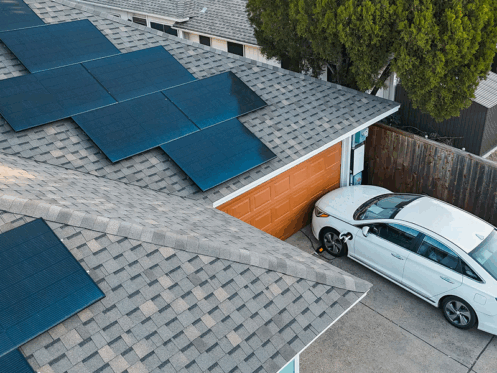If you want to support the environment, reduce your utility bills, and move towards energy independence, investing in solar panels can be a great way to start. However, before making a commitment, you’ll need to have a professional evaluate the condition and suitability of your roof and prepare it to support a solar panel installation.
A qualified installer can assess your roof, recommend necessary repairs and upgrades, help you choose the right panel system, and create a custom installation plan based on your needs.
To ensure that your roof can handle a solar panel installation, your contractor should verify that it’s structurally sound. It must be unaffected by missing shingles, cracks, leaks, or other damage and made from materials that are compatible with the system’s mounting hardware. They should also make sure that your roof is well insulated and ventilated, receives sufficient sunlight, and is spacious enough to accommodate the panel array you need.
Once everything checks out, your contractor can help you choose the right solar panel system for your household and install it in a way that maximizes the return on your investment. Below, we’ll cover the necessary preparations for a home rooftop solar panel installation.
Assess the Age and Condition of Your Roof
Today’s solar panel systems are typically warrantied for 25–30 years and can often continue producing electricity beyond that, though with some efficiency loss. If your roof is more than 20 years old or nearing the end of its life, consider replacing it first. Installing solar panels on a new roof will help you avoid the hassle and cost of removing them if you keep your existing roof and replace it later.
If your roof is relatively new, make sure that it’s in good condition before you go through with solar panel system installation. Putting solar panels on a weak or damaged roof could cause serious and expensive-to-fix structural problems in a short amount of time.
Your installer should check your roof for:
- Missing, curling, cracked, or deteriorating shingles
- Water damage and leaks
- Sagging or uneven areas
- Signs of rot or decay
- Subpar ventilation and insulation
If your installer finds signs of trouble, be sure to address them before you move forward with your panel installation. It’s usually best to install rooftop solar panels in spring or summer, but you can do it any time of year. When you replace or repair your roof and immediately follow up with a solar panel installation, you’ll be able to enjoy the benefits of your home improvements right away.
Check Your Roof’s Compatibility
As you’re making sure that your roof is in good shape, you’ll need to verify that the roof’s materials are well-suited to supporting a solar panel installation. Asphalt shingles and standing seam metal roofs are typically ideal for solar panels. Tile roofs can also work but often require specialized labor, extra brackets, and higher installation costs due to the fragility of the tiles. Wood shake roofs, however, are generally not recommended since they’re more fragile and can pose a fire risk.
Evaluate Your Roof’s Structural Soundness and Load Capacity
A solar panel array typically adds about three to five pounds per square foot to your roof, depending on the system. You need to ensure that your roof can support this load safely. Have your installer, a qualified roofer, or a structural engineer inspect your roof to check for any issues or weak spots that could create a hazard during or after installation.
If your contractor finds a problem, they may recommend that you reinforce or replace part or all of your roof so that it can support the weight of your solar panel system. Adding supplementary framing can also help keep your roof stable throughout the life of your installation.
Your roof may need extra support if it:
- Is aging, weakening, or deteriorating
- Is sagging or uneven
- Has multiple layers of shingles that are weighing it down
- Doesn’t meet current building codes
Consider Your Roof’s Orientation and Pitch
When you know that your roof is structurally able to handle a solar panel installation, you’ll want to figure out how to optimize the amount of energy the array can generate. As you work with your installer to decide where your panels will go, consider how the orientation and pitch of the roof will impact how much sunlight your solar panels can collect.
In the Northern Hemisphere, the sun moves across the southern half of the sky, so installing your panels on a south-facing roof usually maximizes their performance. West- or east-facing roofs can also be viable, but north-facing roofs are the least efficient option and are usually not recommended unless no other option is available.
To capture as much sunlight as possible, your installer should pitch your panels at a 15- to 40-degree angle. If your roof is too steep or too flat, your installer can use mounting hardware to adjust the angle so that the panels gather enough light.
How to Optimize Sunlight Exposure
Evaluating your roof’s exposure to sunlight during each day throughout the year will help your installer determine where to place your solar panels to maximize their energy production. Many installers use solar assessment tools and software to determine the best location for your panels. Your installer should also consider how trees, buildings, chimneys, or other objects cast shade on your roof during the day.
Too much shade can significantly reduce panel performance, but trimming large tree branches or choosing a consistently sunny roof section can help ensure maximum solar output.
Measure Your Roof Space
Once you’ve found a potential location for your solar panels, measure the space on the roof to determine how many solar panels you can install. Multiply the length and width of this area to calculate its full square footage, and make sure to account for obstructions that could reduce your available space. Your installer can help you determine how many panels your roof can accommodate, where to place them, and how much energy your installation is likely to generate.
Get the Necessary Permits and Clear the Roof
Before your contractors can begin working, you’ll need to verify that you’re in compliance with local building codes, zoning requirements, and utility interconnection rules. In some areas, you may also need HOA approval. Many contractors will help obtain the necessary permits to minimize the legwork on your part.
On the day of the installation, you must ensure that your roof is easy to access and clear of debris and obstructions like tree branches, satellite dishes, or antennas. This will ensure that the workers can do their jobs safely and efficiently.
Preparation Is Key to a Flawless Solar Panel Installation
A solar panel installation is a big investment, and you’ll want to do it right. By working with experts at KPost Company and making the right preparations, you can ensure a satisfactory installation and optimize the energy efficiency of your Dallas home.

